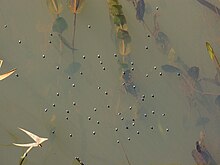Adephaga
| Adephaga | ||||||||||||
|---|---|---|---|---|---|---|---|---|---|---|---|---|

Blue-violet forest beetle ( Carabus problematicus ) |
||||||||||||
| Systematics | ||||||||||||
|
||||||||||||
| Scientific name | ||||||||||||
| Adephaga | ||||||||||||
| Schellenberg , 1806 |


The Adephaga represent the second largest suborder of the beetles (Coleoptera) next to the Polyphaga . The group includes about 34,000 species, with three families living on the ground and the remaining eight families either in water or on water. These are primarily species in which both the adults and the larvae are predatory. Two of the families, the Aspidytidae and the Meruidae , were first described in 2002 and 2005, respectively. The monophyly of subordination is undoubted and well founded by derived characteristics of both the larvae and the adults.
features
The autapomorphies that distinguish the group from the other beetles in the imagines are the two-segment, palp-like galea , the mentum with rounded lateral lobes, a ventral joint on the hips ( coxes ) of the forelegs, very immobile, enlarged hips of the hind legs, which have Completely divide the second abdomen sternitus , the fused sternites on the second to fourth abdominal segment and defensive glands on the pygidium . In the larvae, the autapomorphies are an adaptation to the predatory way of life. Your head has forward-facing mouthparts, the gula (the medial sclerite on the neck) has been changed to a narrow, elongated median suture, the labrum is fused with the frontal plate ( clypeus ), the mandibles lack the cutting surface ( mola ) and the prostheca , a closed prepharyngeal tube is present and digestion takes place extraintestinally .
Plesiomorphic features of the adults are the eleven-parted, thread-like antennae , the mandibles, which lack the mola, the five-parted tarsi , the exposed propleura with free trochantin , wings (alae) with oblongum and four free Malpighian vessels . In the larvae it is probably the four-limbed antennae, the six-limbed legs and the articulated urogomphi .
Taxonomy and systematics
It was assumed that the Adephaga are sisterly to the Myxophaga and Polyphaga , but the latest findings suggest that the Adephaga are more closely related to the Polyphaga.
The relationship within the Adephaga has not yet been fully clarified. One approach assumes that the aquatic families form a monophylum, the Hydradephaga , which is related to the remaining families that belong to the Geadephaga . This was also confirmed by an examination of rDNA sequences from 39 taxa of the Adephaga and 13 other taxa, although the result did not provide a reliable explanation. Another approach assumes that the tumbler beetles (Gyrinidae) are in a sister relationship to the rest of the Adephaga. This is supported by a number of synapomorphies of the remaining families. In addition, the relationship of the water treaders (Haliplidae) is unclear , which could not be demonstrated satisfactorily either on the basis of morphological features or on the basis of molecular genetic studies. This family could be in a sister relationship to a taxon that includes the Carabidae , Rhysodidae , Trachypachidae and Dytiscoidea . However, this approach is not well founded. An alternative to this is the assumption that the Treaders are a sister group of the Dytiscoidea. The Aspidytidae are part of the Dytiscoidea and are possibly in a sister relationship to a taxon which includes the Dytiscidae and Hygrobiidae . The monophyly of the Trachypachidae, Rhysodidae and Carabidae could be confirmed in several studies, whereas the group of the Geadephaga was considered paraphyletic. The position of the Trachypachidae is so far unclear, as there are studies that assign this family to the basal Hydradephaga, whereas others assign them to the Geadephaga.
The subordination includes the following families :
- Aspidytidae Ribera et al. , 2002
- Wet beetle (Hygrobiidae) Regimbart , 1878
- Trout brook beetle (Amphizoidae) LeConte , 1853
- Ground beetle (Carabidae) Latreille , 1802
- Meruidae Spangler & Steiner , 2005
- Wrinkle beetle (Rhysodidae) Laporte , 1840
- Swimming beetle (Dytiscidae) Leach , 1815
- Tumbler beetle (Gyrinidae) Latreille , 1810
- Trachypachidae C. G. Thomson , 1860
- Shore humid beetles (Noteridae) CG Thomson , 1860
- Treaders of water (Haliplidae) Aubé , 1836
supporting documents
Individual evidence
- ↑ a b c d e Rolf G. Beutel, Richard AB Leschen: Handbuch der Zoologie - Coleoptera, Beetles, Volume 1: Morphology and Systematics (Archostemata, Adephaga, Myxophaga, Polyphaga partim) . 1st edition. de Gruyter , 2005, ISBN 3-11-017130-9 , p. 43 f . (English).
- ↑ Peter S. Cranston, Penny J. Gullan: Phylogeny of Insects . In: VH Resh and RT Cardé (eds), Encyclopedia of Insects . Academic Press. Amsterdam 2003; Online (PDF)
literature
- Rolf G. Beutel, Richard AB Leschen: Handbuch der Zoologie - Coleoptera, Beetles, Volume 1: Morphology and Systematics (Archostemata, Adephaga, Myxophaga, Polyphaga partim) . 1st edition. de Gruyter , 2005, ISBN 3-11-017130-9 (English).